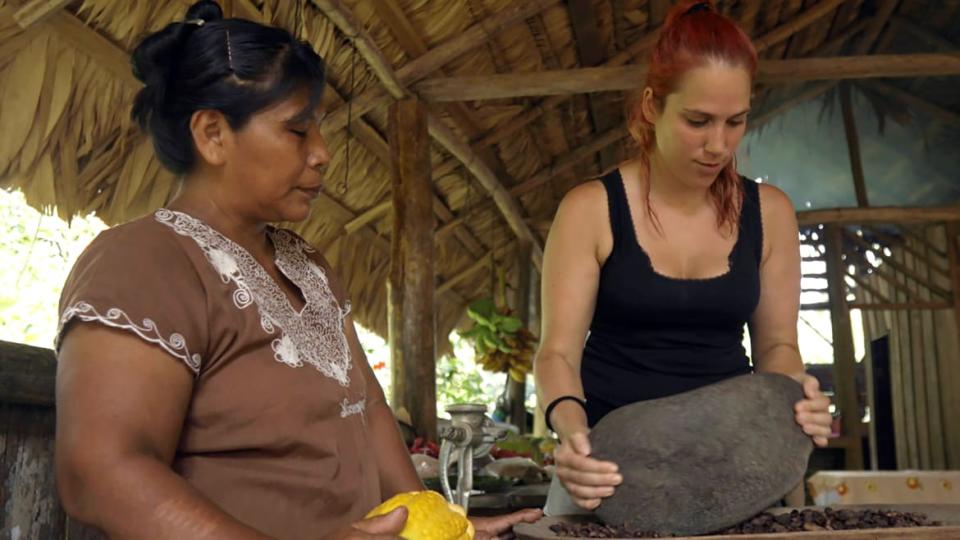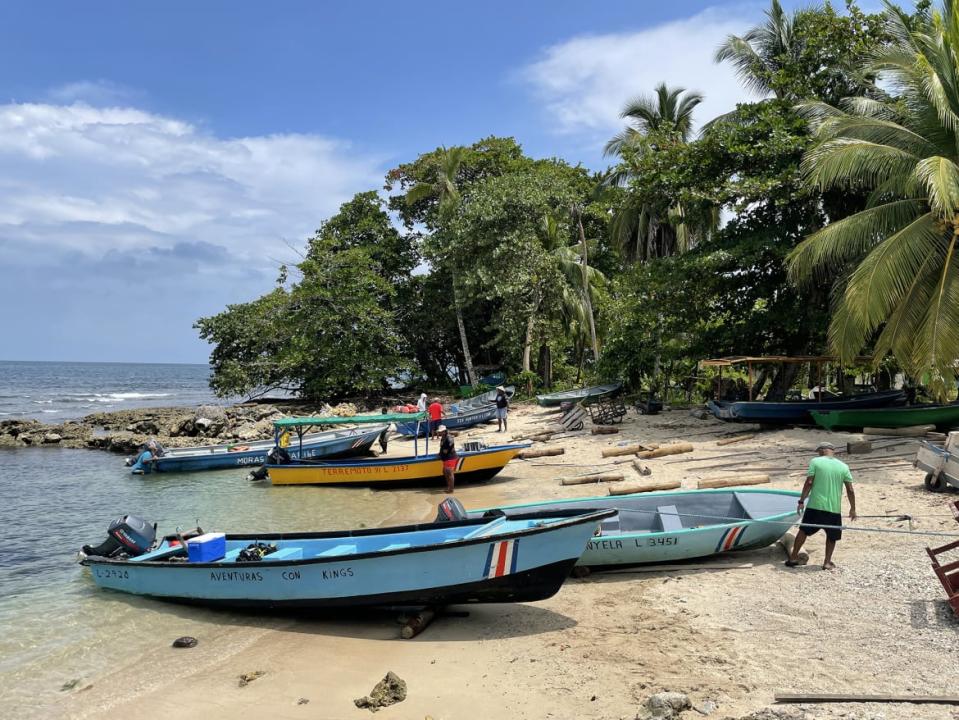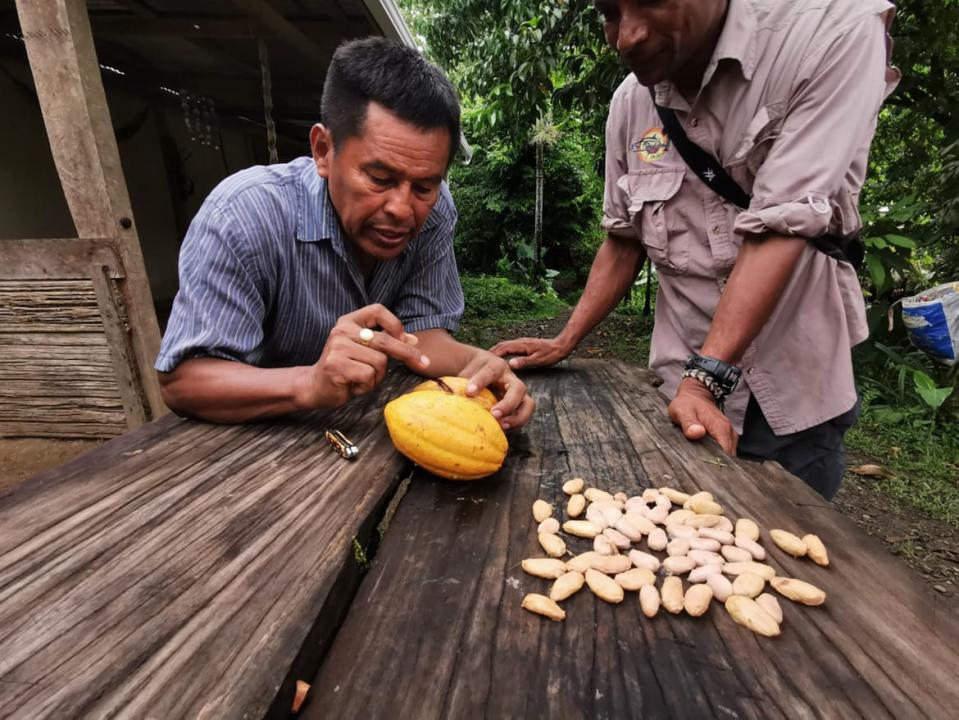In Costa Rica, This Group Makes Sure Your Tourist Dollars Go to Real Locals

Costa Rica is what travel dreams are made of. You can hike along bubbling volcanic mud pits with monkeys prowling overhead, watch brave surfers elegantly navigate towering waves while lying under coconut palm trees, or hug 200-year-old Ceiba trees in the middle of a mountain forest. The country is visually stunning, making it a social media darling especially during quarantine. It also draws travelers who are looking for adventures like ziplining and white water rafting, or those seeking physical and spiritual healing activities like yoga or plant medicine. Even with tourism rates down in Costa Rica because of the pandemic, it became a particularly popular travel destination for many North Americans to get out of their homes and inundate themselves in nature.
However this tourism romance between Costa Rica and North America is not new. In the last 30 years, it emerged into a hotspot especially for travelers and expats from the United States and Canada. Eighty percent of travel is related to ecotourism and the theme is ever-present in the country’s international marketing. While the Pacific coast is still the most visited, those looking for more flavor have been finding the southern Caribbean coast, particularly the county (“canton”) of Talamanca. It is unique in that it is home to the indigenous Bribri community and the Afro-descendant Costa Ricans, and it was the only part of Costa Rica that was not colonized by the Spaniards. Talamanca includes Puerto Viejo, Cahuita (known for its lush national park), Manzanillo, and the Kéköldii indigenous territory among other coastal and mountain communities. Eighty-eight percent of Talamanca is protected land because of its biodiversity, and it is also the most culturally diverse. It boasts a distinctly Caribbean feel, from the omnipresence of reggae and rice and beans to the interconnectivity of the locals with nature.
Frankly, for decades, people didn’t want to visit Talamanca because of racism. Domestic and international travelers believed it was dangerous because it is where the Black people live. While this is not unique to Costa Rica, it’s baked into the country’s history. The Costa Rican government had policies dating back to the 1860s barring certain nationalities and ethnicities from entering the country (i.e. people of African or Chinese descent). When they allowed Jamaicans to migrate to help build the railroads in the late 1800s, they were essentially banned from moving to other parts of the country when the project was finished 20 years later. The Afro Costa Ricans (Afrodescendientes) built up Puerto Viejo which was originally swamp land.
At the same time in the early to mid-1900s, Talamanca was (and still is) also ideal for growing cacao, Costa Rica’s main cash crop at the time. But for indigenous and Afro-descendant communities, it was more than a money maker. It is a spiritual plant and also incredibly healthy, full of antioxidants and anti-inflammatory benefits. When a fungus completely destroyed all of the cacao plants in the late 1970s, it also tanked the economy. Jobs disappeared and the young people who could flocked to the city for new opportunities, or went into construction. The United Fruit Company took over many of these farms, creating massive banana plantations, using pesticides that greatly affected community health and eliminating many of the native spiritual plants.
Meanwhile tourism was growing into a multimillion-dollar global industry, and surfers started to flock to Puerto Viejo to ride the unique “Salsa Brava” waves which could only be experienced in the small coastal town. Noticing the cultural and environmental changes exacerbated by tourism, concerned locals came together in the late 1980s to create ATEC, Asociación Talamanqueña de Ecoturismo y Conservación. The multicultural group saw what was happening in places like Mexico and wondered if they as a community could direct the type of tourism they wanted while preserving the land and the culture. ATEC officially became a non-profit organization in 1990 focusing on supporting locals to earn money through tours along with conservation efforts around the region. They pioneered ecotourism in Talamanca.

Veronica’s Place has become a “must visit” in Puerto Viejo.
“We believe ‘compatir en tal vez de competitir,’” affirmed Waltraud Bethel, known locally as Kiana, one of ATEC’s original co-founders. The phrase translates to “share instead of compete.” Kiana was one of the first foreigners to visit and stay in Puerto Viejo while traveling throughout Central America 40 years ago. Soon after she arrived, she connected with a local indigenous man named Mauricio and learned farming, harvesting, recognizing animal tracks, plant medicine and more about local indigenous traditions.
“Everyone was on horseback and the farm was the supermarket!” she remembers. She saw tourism becoming a sustainable economic alternative as more European travelers started to visit and helped Mauricio create cultural tour opportunities at his farm to share his knowledge of the land, becoming the first guide in the area. Kiana knew the mindset of the backpackers who were visiting—they wanted to know more about the things he considered basic parts of life. It became a means of intercultural exchange; Mauricio was just as curious about the tourists and their way of life. Kiana shared that some locals thought his success was because he was with a foreign woman, but she and Mauricio helped other local farmers to package their knowledge for international visitors. Together with local Afro-descendant families and artisans, ATEC became a community resource in Puerto Viejo and all of Talamanca. Even though they lost their brick and mortar home on the main road due to the pandemic, ATEC is now a government recognized “cultural institute.” They serve tourists and travelers who want to book tours via their website, and continue to be active at the local, regional and countrywide levels.

Kiana will tell you quite clearly that ATEC is not a tour company, it is a nonprofit organization. “ATEC is a platform for local guides to have better income.” She shares with pride that their previous office was the area’s first “internet cafe” (remember those?) and that “we were the post office before there was a post office.” While their overall focus is the preservation of the land and culture, the foundation of ATEC is ensuring local tour guides are paid fairly for their time, work, and knowledge. ATEC guides are experts on birds, animals, medicinal plants and the sea. Unlike many of the various tour companies operating around Puerto Viejo, ATEC only works with guides who are licensed and certified by the government, and helps individuals through the long and costly process to get certified. Many travel agencies are based in the capital, San Jose, and will charge inflated prices to tourists for tours by unlicensed guides who only earn a small percentage. It’s both greedy and dangerous considering that many of the excursions include slippery hikes to waterfalls or snorkeling in the sometimes rough Caribbean sea. Instead ATEC works as an intermediary so travelers pay the guides directly. Furthermore, visitors get to experience Talamanca via local indigenous and Afro-descendant people who know the land intimately. Carlos, a guide who’s worked with ATEC for years, shared how important ATEC is for guides to make a solid living from their work. “ATEC pays very fairly to the tour guides, they’re not trying to rip us off like most of the companies,” he explained. “They (travel agencies) make the product extra expensive but they don’t want to pay the guides well,”
In addition to supporting the local economy, ATEC has been at the forefront of the conservation movement. “We know tourism is up and down, we know it is something that can go away,” Kiana admitted. “We want a sustainable economy at least for Talamanca on a regional level.” She shared that Talamanca is seen as the “rebellious kid” of the country because of the powerful movements against developers that come out of this region. Local activists have successfully fought off proposed oil drilling and marina projects over the last 40 years that would have completely destroyed the coastline and the communities living there.

“Talamanca is always resisting. We were never conquered by the Spanish,” said the newly named executive director, Lauren Mora Rodriquez, who got involved with ATEC as an activist. She first visited Talamanca as a teen working with indigenous youth around sexual and reproductive health and intrafamilial violence. As a young adult she moved to San Jose for university and found a solid corporate job after graduation. Four years ago, while recovering from a moto accident, she remembered her time in Talamanca and felt called to come back to reconnect with the healing power of nature and the indigenous communities. Lauren ended up back in Puerto Viejo volunteering with ATEC and using her education and work experience with government and corporate contracts to help local advocates fight extractive developers. Now she is the executive director helping to solidify the organization as they grow alongside the local tourism industry and foreign development.
Currently, they are still grounded in their mission to support conservation and cultural ecotourism projects. ATEC has been a part of launching an iguana reserve which opens in December, building a Bribri cultural school to preserve the language and culture for future generations, and helping design the proposed pedestrian zone in the center of Puerto Viejo to eliminate traffic. Amidst all of this activity, travelers, educators, documentarians and others from around the world contact ATEC every day to book tours or get historical or scientific information about Talamanca. ATEC continues to live out their original mission, appealing to tourists who want to deeply connect with the unique mix of cultures and the land’s unequivocal natural beauty.
As more North Americans put Talamanca on their travel bucket list, Kiana and Lauren hope that they will disconnect from the overconsumption and hustle mentality once they arrive. “I want visitors to bring back in your mind—like luggage—the values that you learned about here and what connects us as people all over the world,” Kiana offers. She also wants folks to ask themselves what they can do back to their country to help preserve this space, for example buying organic bananas. Lauren encourages tourists to come to connect with nature’s healing energy and the people who love the land. She feels compassion for people living in the “concrete reality.”
“They feel day to day maybe tired, maybe alone, maybe they feel heavy, maybe they ask ‘What is my life and what do I need to do?’ Every human knows there’s something more,” she said with a look of deep concern and care. “The rivers, flowers, birds, nature is calling... Don’t resist.”
Get our top stories in your inbox every day. Sign up now!
Daily Beast Membership: Beast Inside goes deeper on the stories that matter to you. Learn more.

 Yahoo Finance
Yahoo Finance 